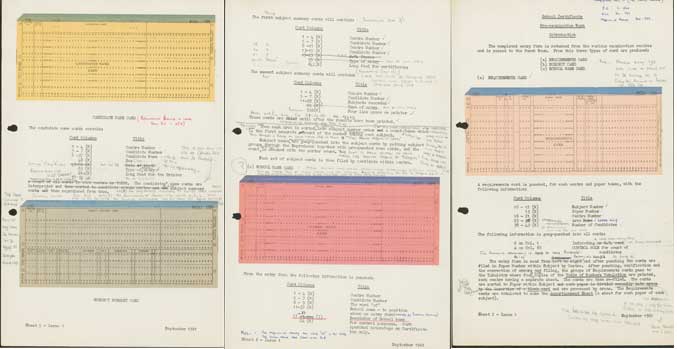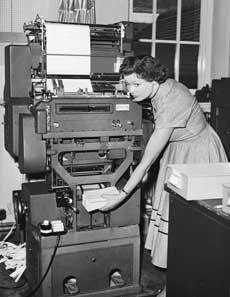From an abacus to an IBM - how did our technology evolve throughout the twentieth century to support the marking of our examinations?
For as long as students have been sitting our examinations, examiners have been marking scripts and the examination boards have been processing the data using various methods of technology.

Throughout the twentieth century, technological advances were progressive, if not particularly linear. The abacus, shown bottom right in the photograph above, was used until 1976, at least a decade after the introduction of the Brunsviga calculating machine. The punched card system was trialled in the late 1960s, accompanied by the workflow diagram. Punched cards (some examples of which are pictured, above) were later introduced for recording candidate marks in a whole range of examinations.
 In 1957 the punch card operators worked at Mill Lane (one of whom is pictured right) and created one card for each subject plus a candidate details card. There were thousands of cards and they were wheeled round to meetings on a tray. After the IBM computer was introduced, some information could be stored on disc and the bulk was reduced considerably. But computer work was very physical; the programmed controlled computer was a huge machine and you had to keep walking around it to work it so you couldn’t sit down.
In 1957 the punch card operators worked at Mill Lane (one of whom is pictured right) and created one card for each subject plus a candidate details card. There were thousands of cards and they were wheeled round to meetings on a tray. After the IBM computer was introduced, some information could be stored on disc and the bulk was reduced considerably. But computer work was very physical; the programmed controlled computer was a huge machine and you had to keep walking around it to work it so you couldn’t sit down.
In the 1980s laser printing was introduced. Initially it was considered for candidate certificates only – to provide improved security and to replace the traditional practice of having to overprint certificates with appropriate signatures.
Gillian Cooke
Group Archivist, Cambridge Assessment